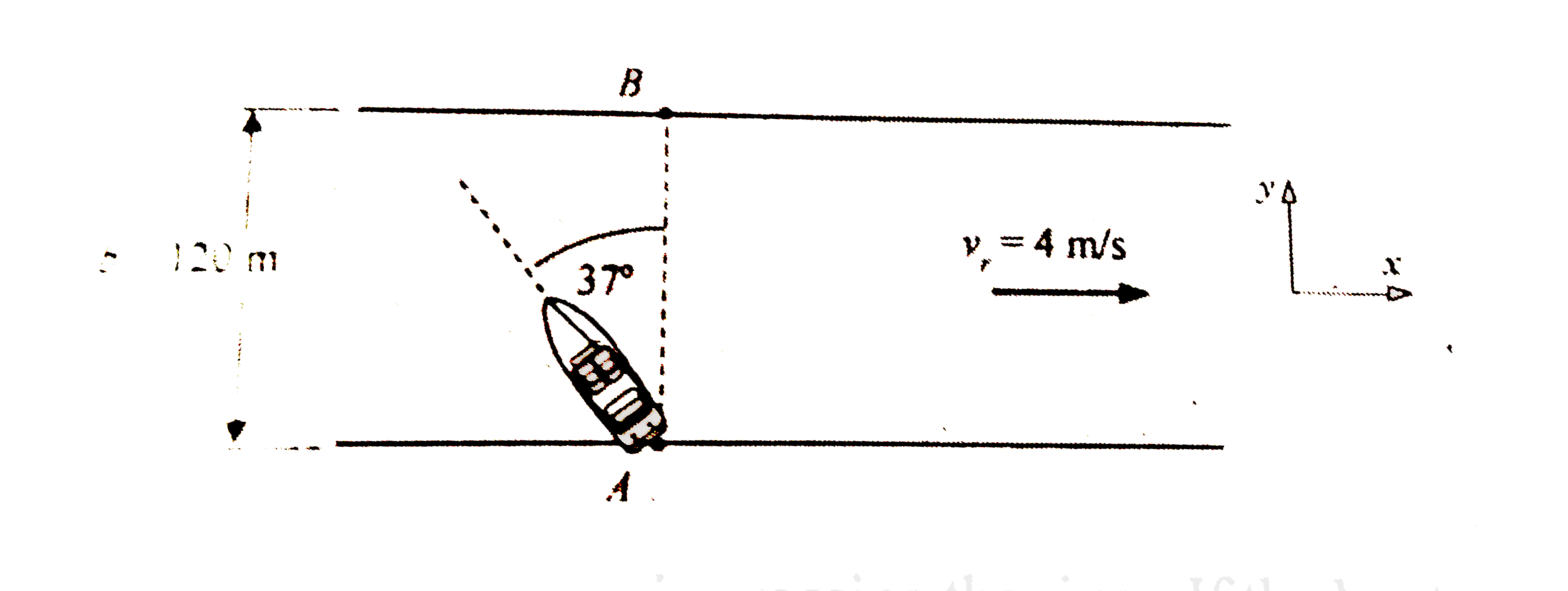A man starts rowing his stationary cuboidal boat of base area A=10m2. The driving force on the boat due to rowing is 100N in the direction of motion. Find the maximum velocity that the boat can achieve. Also find the time in which he will attain half of this maximum velocity. [ Take coefficient of viscosity of water =15 poise ] The depth of the lake is 10m and the combined mass of man and the boat to be 150kg.(u=0, velocity gradient uniform)
The correct Answer is:2003m/s,t=100ln2 seconds
To solve the problem step by step, we will first find the maximum velocity that the boat can achieve and then calculate the time taken to reach half of this maximum velocity.
Step 1: Understand the Forces Acting on the Boat
When the man rows the boat, a driving force Fexternal=100N is applied in the direction of motion. The boat experiences a viscous drag force Fviscous due to the viscosity of water, which opposes the motion. At maximum velocity, these two forces will balance each other.
Step 2: Write the Equation for Maximum Velocity
The viscous force can be expressed using the formula:
Fviscous=η⋅A⋅VmaxD
where:
- η=15poise=15×0.1N s/m2=1.5N s/m2 (conversion from poise to SI units),
- A=10m2 (base area of the boat),
- D=10m (depth of the lake),
- Vmax is the maximum velocity we want to find.
At maximum velocity, we have:
Fexternal=Fviscous
Substituting the values, we get:
100=1.5⋅10⋅Vmax10
Step 3: Simplify and Solve for Maximum Velocity
Now, simplify the equation:
100=1.5⋅Vmax
Vmax=1001.5=2003m/s≈66.67m/s
Step 4: Find Time to Reach Half of Maximum Velocity
To find the time taken to reach half of the maximum velocity Vmax/2, we need to set up the equation of motion.
1. The net force acting on the boat at any time t is given by:
Fnet=Fexternal−Fviscous=m⋅a
where a=dVdt.
2. The viscous force at any velocity V is:
Fviscous=1.5⋅10⋅V10=1.5V
3. Thus, the equation becomes:
100−1.5V=150dVdt
Step 5: Rearranging and Separating Variables
Rearranging gives:
dV100−1.5V=1150dt
Step 6: Integrate Both Sides
Integrate both sides from V=0 to V=Vmax2=100/32=503 and from t=0 to t=t:
∫5030dV100−1.5V=1150∫t0dt
The left side integrates to:
−11.5ln|100−1.5V|∣∣∣5030=−23(ln(100−1.5⋅503)−ln(100))
Calculating gives:
=−23(ln(50)−ln(100))=−23ln(0.5)
The right side gives:
t150
Step 7: Solve for Time t
Equating both sides:
−23ln(0.5)=t150
Thus,
t=−100ln(0.5)
Final Result
Calculating t:
t≈100⋅0.693≈69.3s
Summary of Results
- Maximum Velocity Vmax=2003m/s≈66.67m/s
- Time to reach half of maximum velocity t≈69.3s
Fviscous=η⋅A⋅VmaxD
where:
- η=15poise=15×0.1N s/m2=1.5N s/m2 (conversion from poise to SI units),
- A=10m2 (base area of the boat),
- D=10m (depth of the lake),
- Vmax is the maximum velocity we want to find.
Fexternal=Fviscous
Substituting the values, we get:
100=1.5⋅10⋅Vmax10
100=1.5⋅Vmax
Vmax=1001.5=2003m/s≈66.67m/s
Fnet=Fexternal−Fviscous=m⋅a
where a=dVdt.
Fviscous=1.5⋅10⋅V10=1.5V
100−1.5V=150dVdt
dV100−1.5V=1150dt
∫5030dV100−1.5V=1150∫t0dt
−11.5ln|100−1.5V|∣∣∣5030=−23(ln(100−1.5⋅503)−ln(100))
Calculating gives:
=−23(ln(50)−ln(100))=−23ln(0.5)
t150
−23ln(0.5)=t150
Thus,
t=−100ln(0.5)
t≈100⋅0.693≈69.3s
- Maximum Velocity Vmax=2003m/s≈66.67m/s
- Time to reach half of maximum velocity t≈69.3s
Topper's Solved these Questions
- DAILY PRACTICE PROBLEMSBOOK - RESONANCE ENGLISHCHAPTER - DAILY PRACTICE PROBLEMSEXERCISE - dpp 89 illustration
5 Videos
- DAILY PRACTICE PROBLEMSBOOK - RESONANCE ENGLISHCHAPTER - DAILY PRACTICE PROBLEMSEXERCISE - dpp 90 Illustration
2 Videos
- DAILY PRACTICE PROBLEMSBOOK - RESONANCE ENGLISHCHAPTER - DAILY PRACTICE PROBLEMSEXERCISE - dpp 88
7 Videos
- CURRENT ELECTRICITYBOOK - RESONANCE ENGLISHCHAPTER - CURRENT ELECTRICITYEXERCISE - Exercise
53 Videos
- ELASTICITY AND VISCOCITYBOOK - RESONANCE ENGLISHCHAPTER - ELASTICITY AND VISCOCITYEXERCISE - Advanced Level Problems
9 Videos
Similar Questions
A motor boat is racing towards North at 25km/h and the water current in that region is 10km/h in the direction of 6000 East of South. Find the resultant velocity of the boat.
View SolutionThe velocity of water in a river is 18kmh−1 near the surface. If the river is 5 m deep, find the shearing stress between the horizontal layers of water. The coefficient of viscosity of water =10−2poise.
View Solution
Knowledge Check
A motor boat is racing towards North at 25km/h and the water current in that region is 10km/h in the direction of 60∘ East of South. Find the resultant velocity of the boat.
A11 km h−1B22 km h−1C33 km h−1D44 km h−1
The velocity of water in a rier is 18kmh−1 near the surface. If the river is 5 m deepm, find the shearing stress between the horizontal lyers of water. The coefficient of viscosity of water =10^-2 poise.
View SolutionA man is rowing a boat with a constant velocity v0 in a river. The contact area of boat is 'A' and coefficient of viscosity is η. The depth of river is 'D' . Find the force required to row the boat.
View SolutionVelocity of the boat with respect to river is 10 m/s. From point A it is steered in the direction shown to reach point C. Find the time of the trip and distance between B and C

View SolutionVelocity of the boat with respect to river is 10m/s. From point A it is steered in the direction shown. Where will it reach on the opposite bank ?

View SolutionA man of 50kg is standing at one end on a boat of length 25m and mass 200kg.If he starts running and when he reaches the other end, has a velocity 2ms−1 with respect to the boat.The final velocity of the boat is
View SolutionA man of 50kg is standing at one end on a boat of length 25m and mass 200kg.If he starts running and when he reaches the other end, has a velocity 2ms−1 with respect to the boat.The final velocity of the boat is
View SolutionThe width of a river is 2√3 km. A boat is rowed in direction perpendicular to the banks of river. If the drift of the boat due to flow is 2 km, the displacement of the boat is
View Solution
